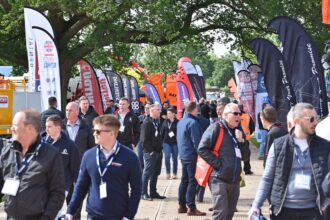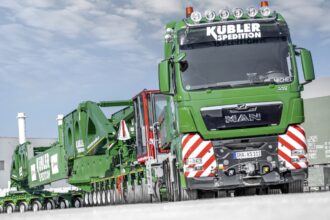Felbermayr Deliver TBMs for the World’s Longest Underground Railway
THE WORLD’S LONGEST UNDERGROUND RAILWAY CONNECTION IS BEING BUILT BENEATH THE BRENNER PASS, AT A LENGTH OF 55 KILMOETRES. FELBERMAYR BEGAN TRANSPORTING TWO NEW 270 TONNE TUNNEL BORING MACHINES.
The stretch from the temporary construction site south and above Innsbruck to the assembly caverns is only just under six kilometres long, but the route is tough going. It runs entirely in tunnels, three kilometres of which have a gradient of up to twelve percent, and the tracks in the mountains are wet, making traction difficult.
“We used the self-propelled SPMT units from Scheuerle with six, ten or twelve axles for these transports; twelve were used for the largest piece weights of 270 tonnes each for the two drives with a diameter of 7.8 metres,” explains project manager Markus Meusburger, Departmental Manager of Felbermayr transport and lifting technology in Lauterach. These drives had been pre-assembled on the factory floor. “With a total weight of almost 300 tonnes and the steep gradient, we reached the mathematical limit of the brakes, so in order to safely carry out these transports nonetheless, we used a four-axle heavy-duty tractor as an additional braking vehicle. It took us roughly three hours to cover the first three kilometres with the steep gradient, and five hours to complete the entire route.”
The roughly 30 transports per tunnel boring machine entailed passing narrow branches, whereby “manoeuvring with centimetre precision was necessary in these areas, and that was probably the greatest challenge,” describes Meusburger. Some components of the tunnel boring machines were less heavy but bulky. “Parts of the so-called trailer are 15 metres long, 4 metres wide and 4 metres high. Because it was very narrow towards the tunnel ceiling, one employee spent five hours sitting on the load in order to precisely instruct his colleague, who was driving the self-propelled unit.” In addition to these special transports, there were countless trips for small parts and assembly material in smaller vehicles.
Once inside the large assembly caverns, the parts were unloaded and rotated in to the assembly positions using a 1,000-tonne lifting frame from the Felbermayr subsidiary Wimmer Maschinentransporte. The individual parts were then gradually assembled into a large complete unit. This included the 250-tonne drill head with a diameter of 10.7 metres. Each of the two identical tunnel boring machines weighs an almost unimaginable 2,000 tonnes complete with the trailer – which itself includes the entire infrastructure such as the transport of demolition material, transformers, electrics, water pipes, compressed air and support material. These technically demanding assemblies were planned and implemented by the Felbermayr Engineered Solutions division.
Felbermayr had also been awarded the delivery contract. “From the manufacturer Herrenknecht in Schwanau in Baden-Württemberg, 97 road transports were required for a tunnel boring machine alone, and a further 30 for the trailer produced in Slovakia,” explains Meusburger. “As such, that was a massive undertaking.” Likewise, the entire transshipping of the parts on the construction site was carried out with heavy-duty cranes in various sizes, coordinated by Felbermayr transport and lifting technology in Wörgl. Lift trucks and working platforms were also put to use. At the end of May, Felbermayr completed the project with the transport of two locomotives, which weighed in at around 40 tonnes and were transported by SPMT from the construction site installation area to the underground transfer point. The two railway vehicles ensure the material supply for the tunnel boring machine.
The large-scale project had been in preparation for years, as Meusburger reflects. “We prepared route studies, investigated numerous transport routes and were fortunately able to fix the project with the client at the end of 2022” Incidentally, this was not the first time the Felbermayr team had worked on the Brenner Base Tunnel: “We previously delivered a smaller tunnel boring machine for the exploratory tunnel in 2015 and transported it to the cavern.”








